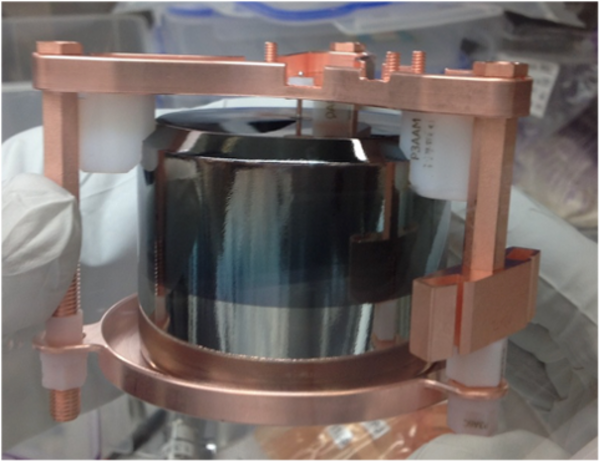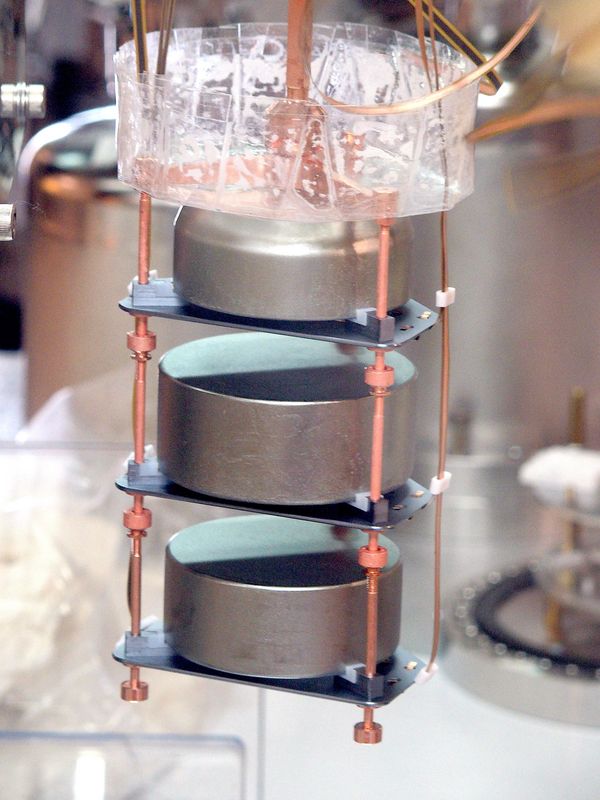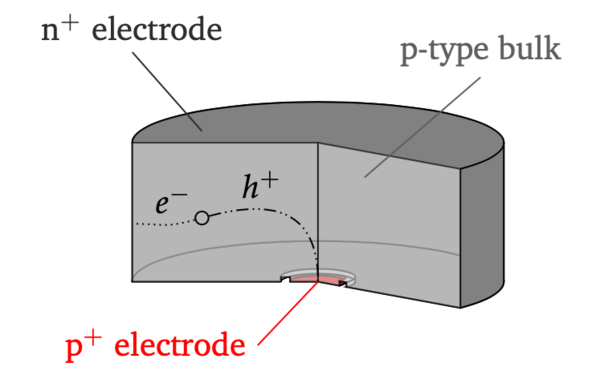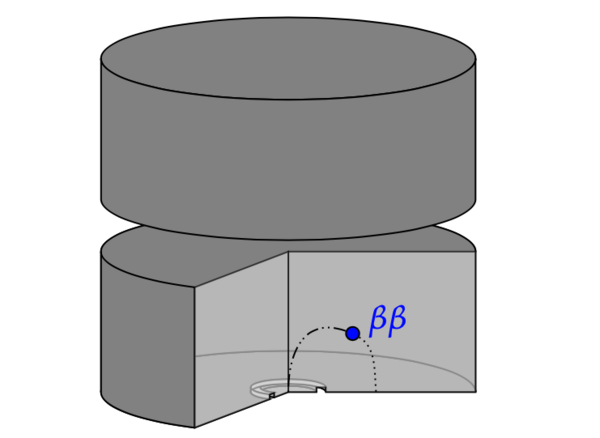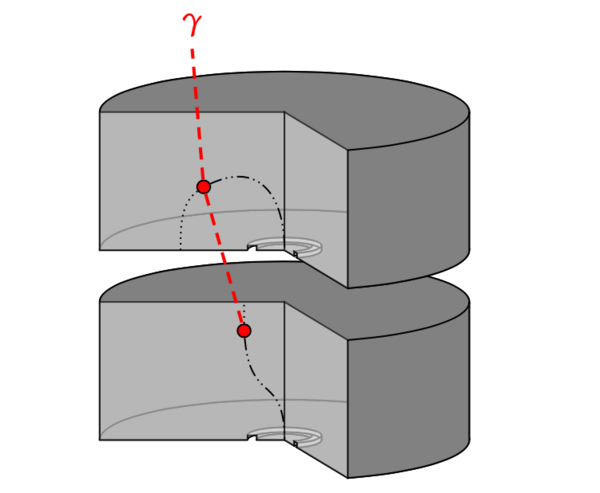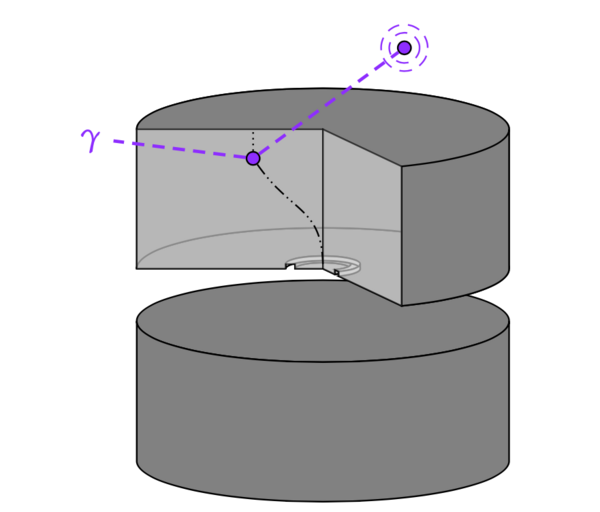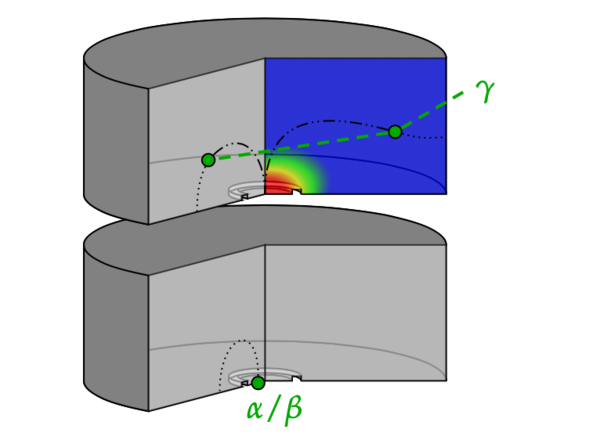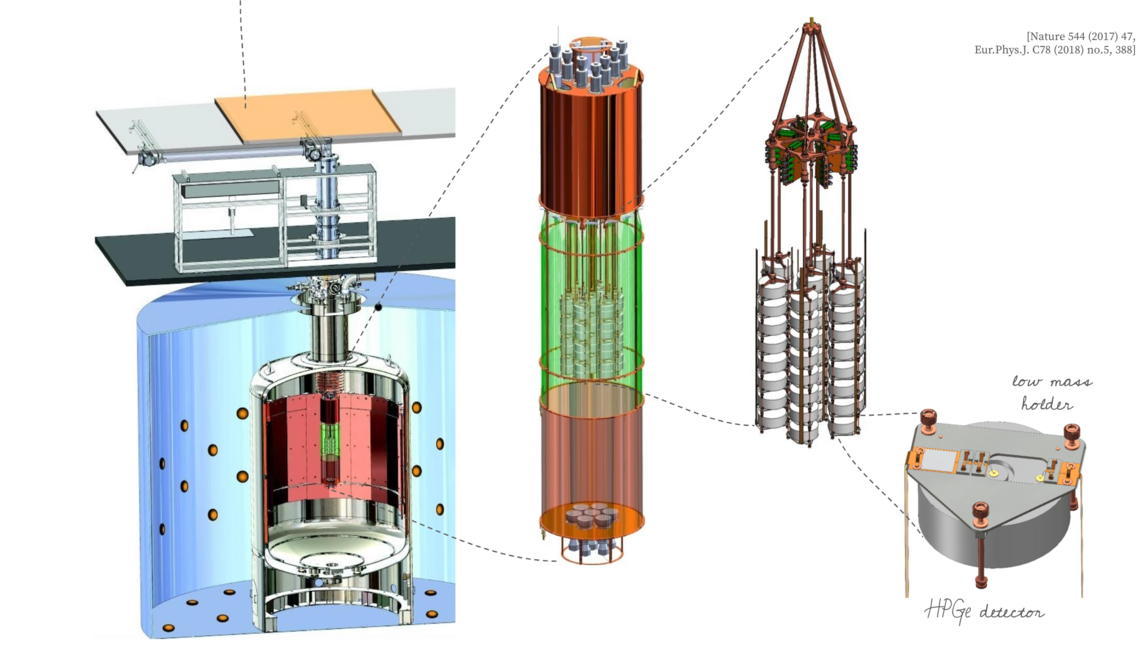Germanium Detectors
& possible events
In this image are represented several Ge detectors, like the ones which will go into LEGEND, and different possible interactions within the detectors. The Pulse Shape Discrimination (PSD) and active veto of the background events, allows for a unambiguous determination of a 0νββ decay.
Experimental approach
Semi-conductor detectors, made from isotopically modified high purity germanium (HPGe) material and deployed in an instrumented liquid argon (LAr) bath, represent LEGEND’s choice for a background-free 0νββ decay search. With the germanium detectors constituting simultaneously source and absorber, maximum detection efficiency for bulk ββ decay is achieved. Backgrounds that feature a topology different from signal-like single-crystal single-site energy depositions are likely to be identified by means of active background suppression.
► Why germanium?
• The natural abundance of 76Ge is only about 8%, but enrichment at the level > 90% isotopic 76Ge fraction in ample quantities is possible. Enrichment is a well established process and allows for an industrial production of 76Ge enriched detectors.
• Germanium detectors are commercial products that act both as source and detector, yielding an excellent detection efficiency.
• Moreover, Ge detectors exhibit the best energy resolution of any ββ detector.
• They neither contain Th nor U contaminations inside the detector.
• Germanium detector experiments (MAJORANA and GERDA) have achieved the lowest background normalized to δE of any ββ experiment and operate in the regime where the half-life sensitivity scales almost linearly with the exposure.
► HPGe detectors
In a p-n junction, the diffusion of majority carriers generates a depletion layer without free charge carriers. The electric field created in this space charge region opposes further diffusion, and equilibrium is established. Under reverse bias, the depletion layer enlarges into the volume of lowest doping concentration. The depletion depth increases for lower impurity concentrations.
HPGe detectors feature a p-i-n structure, where depletion develops within the intrinsic material, that has an impurity concentration of only O (1010 ) atoms/cm3 . Energy depositions in this region may elevate electrons (e−) into the conduction band and respectively gener- ate vacancies, i.e. holes (h+), in the valence band. Their subsequent drift within the established electric field induces a mirror current at the electrodes, i.e. a signal. The depleted volume represents the detector’s active part. The bias voltage required to achieve maximum depletion is referred to as depletion voltage.
Germanium is a direct semiconductor with a bandgap of 0.66 eV. Leakage current due to thermal production of e−- h+ pairs requires operation at cryogenic temperatures, e.g. liquid nitrogen (LN2) o LAr temperature. Energy depositions by ionizing radiation create a proportional amount of charge carriers. The average energy required to create an e−- h+ pair in germanium is 2.96 eV.
Statistical fluctuationsl imit the energy resolution of the device, whereas correlations with emerging phonons result in a behavior differing from pure Poisson statistics. The Fano factor of germanium is 0.13. Both, the low energy needed to create e−- h+ pairs and the small Fano factor, allow for an excellent energy resolution of O (0.1) % at MeV-energies.
The high mobility of charge carriers allows to construct large de- tectors of O (1) kg from HPGe crystals. This, combined with the high efficiency for γ ray absorption and the superb resolution, makes HPGe detectors a common choice in γ spectroscopy1.
The intrinsic material of the GERDA HPGe detectors is of p-type, their n+ electrode is constructed by diffusion of lithium, whereas their p+ electrode is made by boron implantation. The presence of charge carriers in the highly doped p+ and n+ regions leads to incomplete or zero charge collection, i.e. dead layers. The n+ layer has a thickness of O (1) mm, whereas the p+ layer is only O (100) nm thick.
► Active background suppression
HPGe ionization detectors do not allow for particle identification.
Nonetheless, background discrimination can be achieved in terms of event topology. The electrons emerging from ββ decays in the detector bulk will deposit their energy very localized, within O (1) mm . This can be ascribed to the large stopping power of the material, and that Bremsstrahlung is subdominant at ββ-energies. Similar topologies may arise from any internal α or β decay, but it has been shown that bulk contaminations are below any measurable value2. The range of γ radiation is typically larger. At MeV-energies, their mean free path is of O (1) cm. Only up to a few 100 keV full energy transfer via photoelectric absorption dominates, whereas at higher energies, Compton scattering and pair production become prevalent. This leads to a spacially widespread topology, that typically exceeds ββ-like single-site interactions. In LEGEND multiple measures will be taken to access an events topology and thereby actively suppress those that are background-like.
► Detector anti-coincidence
The granularity of several HPGe detectors in an array configuration allows to identify events with energy depositions in multiple detectors. Similar topologies may be produced by any γ-γ or α/β-γ coincidence that releases energy in several detectors.
Detection mechanism
BEGe Detector
0νββ Decay
Multi-detector event
LAr coincidence event
Multi-site and surface events
As a superposition of several single-site interactions, the pulse shape generated from multi-site energy depo- sitions is identifiable by PSA. Surface events by e.g. α or β contaminations generate another class of pulse shapes. The weighting potential is indicated in the upper detector.
Find out more about the Ge detectors for 0νββ-decay:
-
1R. D. Baertsch and R. N. Hall, “Gamma Ray Detectors Made From High Purity Germanium”, IEEE Transactions on Nuclear Science, vol. 17, no. 3, pp. 235–240, (1970)
-
2M. Agostini et al., “Limits on uranium and thorium bulk content in Gerda Phase I detectors”, Astroparticle Physics, vol. 91, pp. 15–21, (2017)
-
Avignone FT III and Elliott SR, "The Search for Double Beta Decay With Germanium Detectors: Past, Present, and Future". Front. Phys. 7:6. (2019)
-
T. Comellato, M. Agostini, S. Schönert, "Modeling the collective motion of charge carriers in germanium semiconductor detectors", arXiv:2007.12910, (2020)
-
A. Domula, et al., "Pulse shape discrimination performance of Inverted Coaxial Ge detectors", Nuclear Instruments and Methods in Physics Research Section A: Accelerators, Spectrometers, Detectors and Associated Equipment Vol. 891 p. 106-110, (2018)


